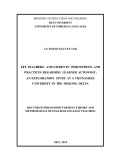
TNU Journal of Science and Technology
230(03): 30 - 37
http://jst.tnu.edu.vn 30 Email: jst@tnu.edu.vn
COMMUNICATIVENESS OF ACTIVITIES IN PRIMARY ENGLISH
CLASSROOMS AMID CURRICULUM REFORM IN VIETNAM
Bui Le Diem Trang*, Tran Thi Bich Dung, Lu Thi Thu Nguyen, Nguyen Dang Khoa
An Giang University - Vietnam National University Ho Chi Minh City
ARTICLE INFO
ABSTRACT
Received:
09/10/2024
This study investigated the degree of communicativeness in activities
conducted in primary English classes, along with the factors influencing
their communicative nature. Nine teachers from eight primary schools
in a Mekong Delta province, representing urban, semi-rural, and rural
settings, participated in the study. Classroom observations and semi-
structured interviews were employed, with Littlewood’s (2004)
communicative continuum serving as the framework for analyzing
activities across 27 video-recorded lessons and corresponding field
notes. The findings indicated that most activities exhibited low levels of
communicativeness, with urban teachers implementing more
communicative activities than their semi-rural and rural counterparts.
Teachers across all settings identified exam pressures, large class sizes,
varying student proficiency levels, and limited time for communicative
practice as major barriers. The study highlights the need to increase
teachers and curriculum developers’ awareness of communicative
approaches and recommends professional development initiatives to
address these challenges in primary English classrooms.
Revised:
10/02/2025
Published:
11/02/2025
KEYWORDS
Communicativeness of
activities
Factors affecting the
communicativeness
Primary English classes
Curriculum reform
Mekong Delta
TÍNH GIAO TIẾP CỦA HOẠT ĐỘNG TRONG LỚP HỌC TIẾNG ANH
Ở CẤP TIỂU HỌC GIỮA BỐI CẢNH CẢI CÁCH CHƯƠNG TRÌNH
GIÁO DỤC PHỔ THÔNG TẠI VIỆT NAM
Bùi Lê Diễm Trang*, Trần Thị Bích Dung, Lư Thị Thu Nguyền, Nguyễn Đăng Khoa
Trường Đại học An Giang - Đại học Quốc gia Thành phố Hồ Chí Minh
THÔNG TIN BÀI BÁO
TÓM TẮT
Ngày nhận bài:
09/10/2024
Nghiên cứu này khảo sát mức độ giao tiếp của các hoạt động trong lớp
học tiếng Anh tiểu học và các yếu tố ảnh hưởng. Chín giáo viên từ tám
trường ở một tỉnh Đồng bằng sông Cửu Long, đại diện cho các khu vực
đô thị, bán nông thôn và nông thôn, đã tham gia. Quan sát lớp học và
phỏng vấn bán cấu trúc được thực hiện, với thang đo giao tiếp của
Littlewood (2004) làm khung phân tích cho 27 bài học. Kết quả cho
thấy hầu hết các hoạt động có mức giao tiếp thấp, giáo viên ở đô thị thực
hiện nhiều hoạt động giao tiếp hơn so với khu vực bán nông thôn và
nông thôn. Các yếu tố như áp lực thi cử, sĩ số đông, trình độ không đồng
đều, và thời gian dành cho thực hành giao tiếp hạn chế được xem là rào
cản. Nghiên cứu kêu gọi nâng cao nhận thức và phát triển chuyên môn
cho giáo viên và người phát triển chương trình giảng dạy nhằm khắc
phục các thách thức trong giảng dạy giao tiếp trong lớp học tiếng Anh
tiểu học.
Ngày hoàn thiện:
10/02/2025
Ngày đăng:
11/02/2025
TỪ KHÓA
Tính giao tiếp của hoạt động
Yếu tố ảnh hưởng đến tính
giao tiếp
Lớp học tiếng Anh tiểu học
Cải tiến chương trình
Đồng bằng sông Cửu Long
DOI: https://doi.org/10.34238/tnu-jst.11270
* Corresponding author. Email: bldtrang@agu.edu.vn








































